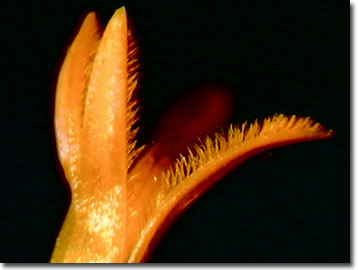Reflected Light Digital Image Gallery
Marigold (Tagetes species)
Marigolds (Tagetes species), annual herbs in the burgeoning flowering family Compositae, are native to Africa, France, South America, Mexico, and New Mexico and are extremely popular with gardeners. A sun-loving plant genus featuring a wide variety of colors and flower-head configurations, this cultured plant is not groomed for its fragrance, which politely can be described as pungent.

View a second image of a marigold (Tagetes species).
View a third image of a marigold (Tagetes species).
View a fourth image of a marigold (Tagetes species).
There are four basic species of cultivated marigold, having dozens of varieties, including hybrids. African or Aztec marigolds, T. erecta, are marketed to meet a demand for large-flowered and tall marigolds. The large-flowered African marigolds are compact, erect, 12 to 14 inches tall, and feature 3.5-inch diameter flowers that bloom earlier than the tall breed and that include primrose yellow through pumpkin orange, but no bicolors. The tall African marigolds reach beyond 36 inches in height and feature large orange or yellow blooms that are grown for cut flowers. T. patula, the French marigold, is cultivated in large-flowered and dwarf varieties. Dwarf French marigolds do not quite reach 12 inches in height, and their flowers are small at 1 to 1.5 inches diameter, in yellow, gold, or orange. These continually flowering annuals (early summer to late fall) are well suited as border plants and in rock gardens, and feature a wide variety of flower shapes and arrangements, as well as bicolored yellow and red breeds. A variety referred to as the "mule marigold" by some horticulturists, a sterile triploid hybrid between the French and African marigold, does well in hot weather and is characterized by 2.5-inch diameter flowers that may be bicolored. Signet marigolds (Tagetes tenuifolia) are simple and daisy-like with long stems, forming bushy plants having fine, lacy foliage. Unlike most other varieties of marigold, the signets bear small, single yellow or orange flowers that are edible, with a spicy tarragon flavor. Unlike the other foul-smelling species, the foliage of the signet marigold has a pleasant lemon fragrance.
Despite the hopes and beliefs of many gardeners, marigolds are not effective for integrated pest management, according to recent research. Many home gardeners still subscribe to this botanical myth and plant alternating rows of marigolds in their vegetable gardens in a futile attempt to repel harmful insects. Although marigolds are rarely troubled by herbivorous insects and diseases, they can be infested with spider mites, aster yellows, and occasionally, are devastated by outbreaks of hungry hordes of grasshoppers.
Contributing Authors
Cynthia D. Kelly, Thomas J. Fellers and Michael W. Davidson - National High Magnetic Field Laboratory, 1800 East Paul Dirac Dr., The Florida State University, Tallahassee, Florida, 32310.
BACK TO THE REFLECTED LIGHT IMAGE GALLERY
BACK TO THE DIGITAL IMAGE GALLERIES
Questions or comments? Send us an email.
© 1995-2025 by Michael W. Davidson and The Florida State University. All Rights Reserved. No images, graphics, software, scripts, or applets may be reproduced or used in any manner without permission from the copyright holders. Use of this website means you agree to all of the Legal Terms and Conditions set forth by the owners.
This website is maintained by our
Graphics & Web Programming Team
in collaboration with Optical Microscopy at the
National High Magnetic Field Laboratory.
Last Modification Friday, Nov 13, 2015 at 01:19 PM
Access Count Since September 17, 2002: 7795
Visit the website of our partner in introductory microscopy education:
|
|
